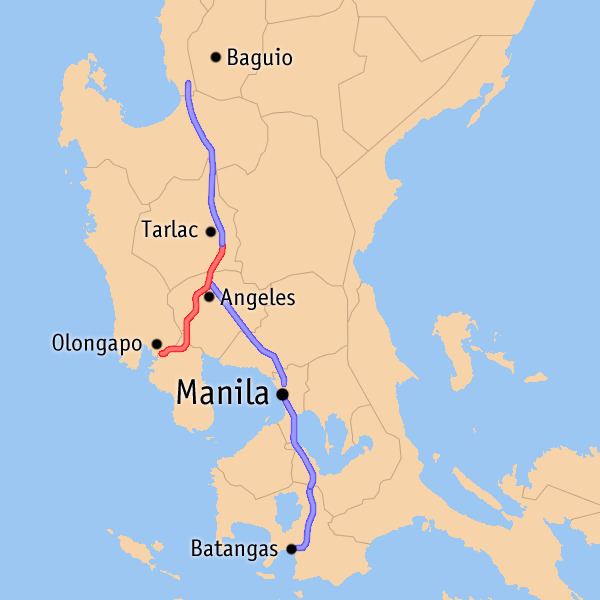Expressway of the Philippines is composed of 10 expressways that connects Metro Manila to the provinces in the North Luzon and South Luzon. As of now not all expressways are interconnected, with a plan in the future to connect all of the expressways to form a network.
The first expressway systems in the Philippines are the North Luzon Expressway, formerly known as North Diversion Road and the South Luzon Expressway (SLEx), formerly known as South Super Highway. Both were built in the 1970s, during the presidency of Ferdinand Marcos. The first Elevated Toll Road in the Philippines is the Metro Manila Skyway or the South Metro Manila Skyway Project, built in 1995 to 1999, during the presidency of Fidel Ramos and Joseph Estrada. The STAR Tollway I, from Santo Tomas to Lipa, was opened in 2001; STAR Tollway II, from Lipa to the Batangas City Port, opened in 2008. The Subic–Clark–Tarlac Expressway or SCTEx Project was initiated under the administration of former President Joseph Estrada with an original project cost of ₱15.73 billion. Construction was started in 2005 under the government of President Gloria Macapagal-Arroyo. It is the longest tollway in the Philippines that connects Subic, Clark and Tarlac. It was completed with a project cost of ₱34.957 billion. In 2008, the SCTEx was formally opened, setting the stage for the development of the TPLEx, which would extend beyond the SCTEx' terminus in Tarlac City.
There are many under construction and proposed expressways in the Philippines. All the Expressways in the Philippines are privately owned.
Asian Highway 26/Pan-Philippine Highway () passes through the two expressway:
- North Luzon Expressway from Guiguinto to Balintawak, Quezon City
- South Luzon Expressway from Magallanes Interchange to Calamba
One expressway is part of Circumferential Road of Metro Manila.
Circumferential Road 5 C-5 Road: North Luzon Expressway Segment 8 and 9
Seven Expressways are part of Radial Road of Metro Manila:
Radial Road 1 R-1: Manila–Cavite Expressway
Radial Road 3 R-3: Metro Manila Skyway, South Luzon Expressway, STAR Tollway
Radial Road 8 R-8: North Luzon Expressway, Subic–Clark–Tarlac Expressway, Tarlac–Pangasinan–La Union Expressway
E1 : North Luzon Expressway, Subic–Clark–Tarlac Expressway (Mabalacat-Tarlac Segment), Tarlac–Pangasinan–La Union Expressway
E2: Metro Manila Skyway, South Luzon Expressway, Southern Tagalog Arterial Road
E3 : Manila–Cavite Expressway
E4 : Subic–Tipo Expressway, Subic–Clark–Tarlac Expressway (Subic-Mabalacat Segment)
E5: North Luzon Expressway (Mindanao Avenue Link/Karuhatan Link)
Balintawak Interchange is a two-level cloverleaf interchange in Quezon City, Metro Manila, the Philippines which serves as the junction between Epifanio de los Santos Avenue (EDSA) and the North Luzon Expressway (NLEx).
Magallanes Interchange is a four-level partial turbine interchange in Makati, Metro Manila, the Philippines, serving as the junction between the South Luzon Expressway (SLEX) and Epifanio de los Santos Avenue
Sales Interchange, also known as the Nichols Interchange, is a hybrid interchange at the boundary of Pasay and Taguig in Metro Manila, the Philippines. It is composed of a lower partial cloverleaf interchange serving as the junction between the South Luzon Expressway and Andrews Avenue (formerly Sales Road), and an upper T-bone interchange serving as the junction between the Metro Manila Skyway and the NAIA Expressway.
Smart Connect Interchange, also known as the Mindanao Avenue Interchange and the North Luzon Expressway–Circumferential Road 5 Interchange, is a two-level cloverleaf interchange in Valenzuela, Metro Manila, the Philippines which serves as the junction between Circumferential Road 5 (C-5) and the North Luzon Expressway (NLEx). Built as part of the 2.7-kilometer (1.7 mi) NLEx–Mindanao Avenue Link segment extending the expressway to Mindanao Avenue, which has since been incorporated into the C-5 system, it is the Philippines' largest cloverleaf interchange in terms of land area.
Guard rails
Rumble strips
Signs and pavement markings
Solid wall fence
Speed radars
Toll Plaza
Closed-circuit television
Rest and service areas (privately owned and operated)
100 km/h for cars and jeepneys, 80 km/h for trucks and buses, and 60 km/h is the minimum for all classes of vehicles.
The first Electronic Toll Collection was introduced in 2001 in the SLEx and Skyway Systems.
Notes:
(♯) Subsidiary of San Miguel Corporation
(°) Subsidiary of Metro Pacific Investments Corporation
The longest expressway in the Philippines is Subic–Clark–Tarlac Expressway with a length of 93.77 km.
The shortest expressway in the Philippines is Muntinlupa–Cavite Expressway with a length of 4.0 km.
The newest expressway in the Philippines is NAIA Expressway which opened in September 2016.
The first and the longest elevated expressway in the Philippines is Metro Manila Skyway.
The first airport expressway in the Philippines is NAIA Expressway.
The first coastal expressway in the Philippines is Manila-Cavite Expressway.
The longest bridge in an expressway is Candaba Viaduct (also known as Pulilan-Apalit Bridge) of North Luzon Expressway with a length of 5.0 km.
The largest interchange is Smart Connect Interchange of North Luzon Expressway.
The largest toll plaza in the Philippines is Bocaue Toll Barrier of North Luzon Expressway with a total of 34 toll lanes.
Metro Pacific Tollways Corp. is the largest operator of expressway in the Philippines, which operates the North Luzon Expressway, Subic–Clark–Tarlac Expressway, Subic–Tipo Expressway and the Manila–Cavite Expressway.

